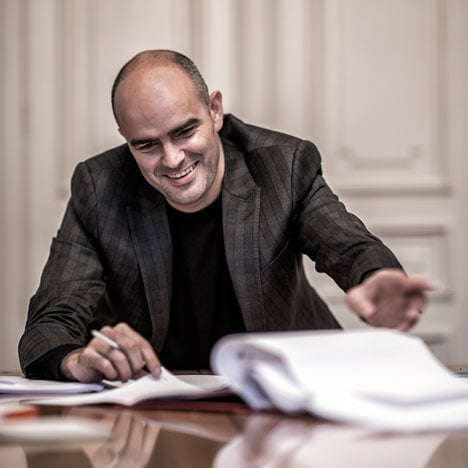
Most design fairs "are not designed"
Interieur 2012: design fairs need to be better designed to provide a better experience to visitors, according the curator of the Interieur design biennale in Kortrijk, Belgium, which opened this weekend (+ interview).
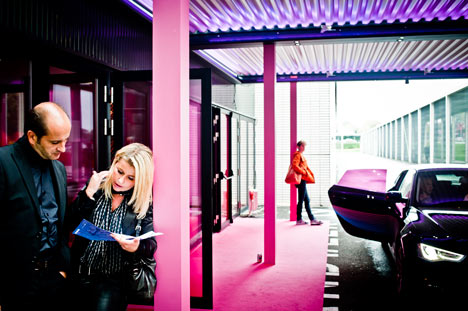
Above: Audi shuttle service linking the Xpo and Buda Island locations
"A lot of them are not designed," said Lowie Vermeersch, the former design director at automotive designer Pininfarina. "To have good design you also need to have culture; you need artistic aspirations."
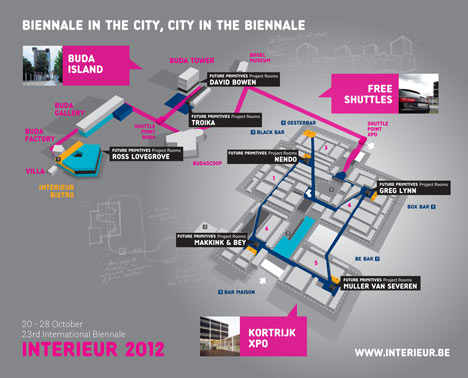
Above: layout of Interieur 2012
Vermeersch said that most design fairs are confusing, badly planned and too large for visitors to enjoy. "I sometimes get a bit frustrated coming back from Milan and feeling that even though I travelled a lot, I missed a lot," he told Dezeen. "It's a lot of logistics while you're there, and a lot of planning. It would be better to just focus on exploring the design, and cut out all the logistic considerations you have to make to plan your day."
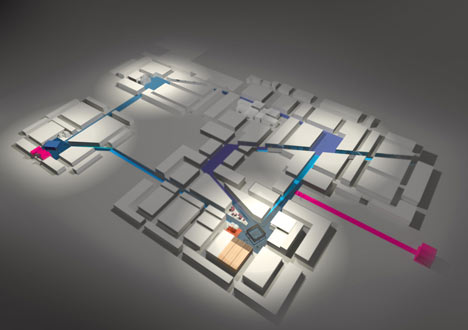
Above: graphics made for Interieur 2012
Vermeersch, who was born in Kortrijk and became curator of the fair last year, has introduced an urban-style layout at the Xpo building on the edge of the city, that houses the trade fair part of the event, complete with boulevards, lanes and squares with bars and restaurants.
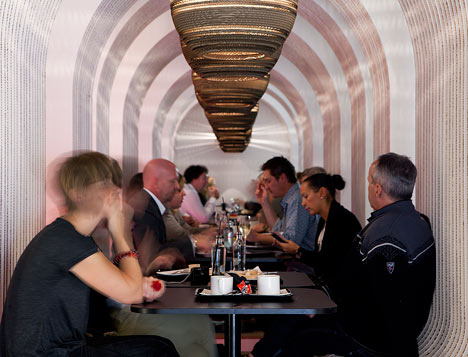
Above: cafe at Buda Island
In addition there is a cluster of exhibitions at Buda Island in the city. The two locations are linked by a continuous shuttle service provided by Audi, which is free to all visitors. "The whole visit should be pleasant experience," said Vermeersch. "For me Interieur is a real design event, not just because it's showing design, but also because it's conceived as design."
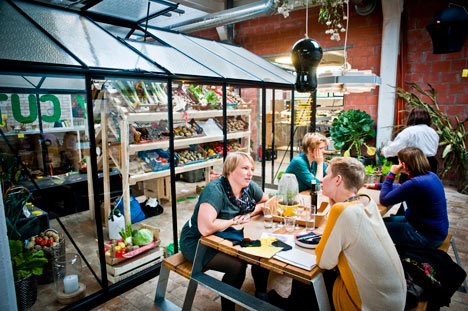
Above: cafe at Buda Island
Dotted around both the Xpo building and the Buda Island locations are a series of exhibits responding to the Biennale's central theme, Future Primitives, with specially commissioned projects by designers including Troika, Greg Lynn, Nendo and Ross Lovegrove.
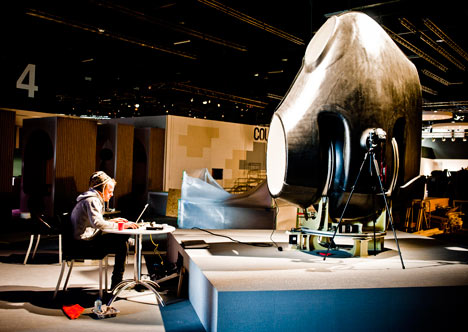
Above: Future Primitive installation by Greg Lynn. Image by Wouter van Vaerenbergh
In April we published a video interview with Vermeersch, in which he set out his vision for Interieur. The fair has taken place every two years since 1968 and is organised by the not-for-profit Interieur Foundation. This year's event runs until 28 October.
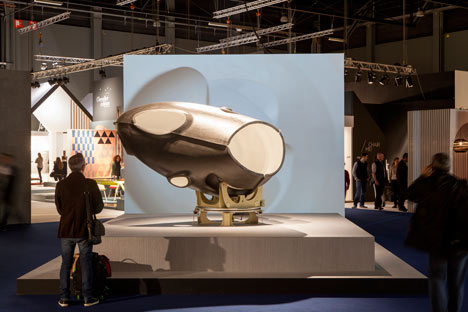
Above: Future Primitive installation by Greg Lynn. Image by Frederik Vercruysse
Here's the transcript of the interview, conducted by Dezeen editor-in-chief Marcus Fairs in Kortrijk yesterday:
Marcus Fairs: There's more and more design festivals, design weeks, design events and so on. It's intimidating and exhausting to visit them all. How can design events stand out from the crowd?
Lowie Vermeersch: For me, value lies in compactness. Being compact means every visitor sees everything, so there's no risk of getting lost in the overload of quantity that we sometimes see.
If you come to Kortrijk, the expo and the events on Buda Island are connected continuously by the shuttle service available for everybody, so there's a kind of mental rest. You don't even have to plan your visit. Everything is selected and curated, and it's served to you on a pleasant scale. We don't want to only select the big brands, we want to show people new things.
Secondly, there's something also we worked very much on, that the whole visit should be pleasant experience. You can see very clearly in the expo that it's not just a regular grid; it's more a city plan with lanes, big streets, small streets, and squares with integrated bars and restaurants. So the whole thing is just a pleasant experience in itself.
Marcus Fairs: Do you think that design fairs are often unpleasant experiences?
Lowie Vermeersch: For me yes. I come from another type of business, automotive design, and I get annoyed when I lose myself between the numbers of the corridors. Every corner is a response to what you already expected. The unexpected is a big thing in not getting annoyed or bored. This is what we tried to do with the scenography: there's unexpected corners, each time you turn a corner there's a new setting. I think that helps to keep your sense also awake.
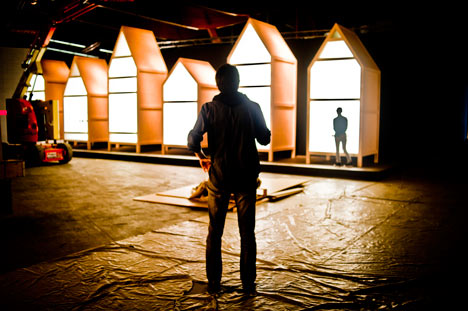
Above: Future Primitive installation by Nendo. Image by Wouter van Vaerenbergh
Marcus Fairs: Do you think that most design fairs are quite badly designed?
Lowie Vermeersch: I think, honestly, a lot of them are not designed. I think a lot of them start from more rational, economical thinking, which to a certain extent is in contrast with the fact that design has that rational economic part but it also has a cultural part. To have good design you also need to have culture; you need artistic aspirations. Interiuer wants to reflect that mix between the economical and the cultural, which design itself is. And for me Interieur is a real design event, not just because it's showing design, but also because it's conceived as design.
Marcus Fairs: How important is it for people to get out of the expo hall in a design fair, and enjoy the city? Because Kortrijk is actually a really pleasant little city.
Lowie Vermeersch: I thought it was very important. Again, it's about creating different impressions, different experiences, so you stay awake. When I was asked to be curator, I thought that the city of Kortrijk, and especially this constellation of buildings that we have here on Buda Island in the centre of the city, had potential that was never fully explored before. They had been some editions [of the fair] where there were a few things in the city, but now with this edition we really want to show the potential of Kortrijk and I'm happy to see a lot of people discover Kortrijk.
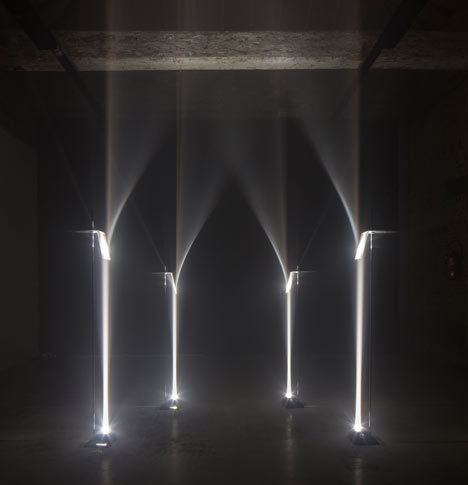
Above: Future Primitive installation by Troika. Image by Frederik Vercruysse
Marcus Fairs: What's your experience of Milan?
Lowie Vermeersch: Milan is a must-go, but personally I sometimes get a bit frustrated coming back from Milan and feeling that even though I travelled a lot, I missed a lot. You can't free up five days to go to see everything. And that's sometimes a bit of frustration to me. It's a lot of logistics while you're there, and a lot of planning. It would be better to just focus on exploring the design, and cut out all the logistic considerations you have to make to plan your day.
Marcus Fairs: So the experience needs to be designed a bit better.
Lowie Vermeersch: Yeah, absolutely. And I think it's a parallel with what design itself is doing. Any object is a means to create an experience So why should an event that wants to share that design, not be conceived itself like that?
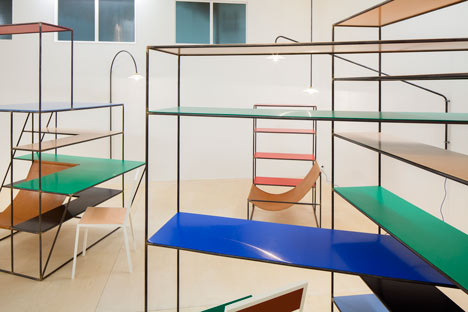
Above: Future Primitive installation by Muller van Severen. Image by Frederik Vercruysse
Marcus Fairs: How do you approach a huge event like Milan? How do you navigate it?
Lowie Vermeersch: This is personally something I feel: you go to Milan, you open the programme and there is such an abundance of things. It is impossible to go and see everything. So you have to make a selection based on the knowledge you already have, even though it's more interesting to go and discover things you don't know about yet. This is why here, on purpose, we mixed the whole thing together so that people will be surprised and confronted with some things that otherwise maybe they would not choose to go to.
Marcus Fairs: So, for example, the come to see the Ross Lovegrove installation because they have heard of him, and then they walk out and into something more unexpected?
Lowie Vermeersch: Exactly. This is a good example of how I created the Biennale. On one hand there is a mix of projects by Ross Lovegrove right next to totally unknown guys doing fantastic research on materials. But, from a content point of view they are linked to each other. It is both about really advanced technology that is so advanced that it touches nature, so from a content point of view, for me, they are related. But in terms of the consciousness of the public, they are not related yet.